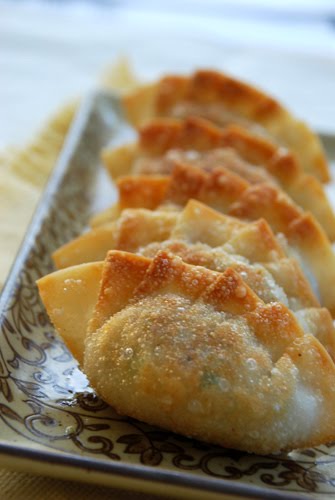 Mandu
Mandu is a Korean dumpling stuffed with a mixture of various meat and vegetables. There are many variations of
mandu. Some classic versions are:
gogi mandu (which has meat as the main ingredient in the filling),
yachae mandu (vegetables) and
kimchi mandu. The cooking method also varies.
Mandu can be steamed (
jjin mandu), deep fried (
tuigin mandu), pan fried (
gun mandu), boiled (
mul mandu), or used to make soup (
mandu guk). Koreans usually make
mandu in large quantities and freeze them for later use. Frozen
mandu is easy to prepare as a delicious snack, appetizer, or meal, making it a home-cooked favorite for my two kids away at school.






1 package
mandu pee (dumpling skins/wrappers) (usually 40 - 50 pieces)
Filling1/2 lb ground pork (or other meat if preferred)*
1/4 lb ground shrimpor ground beef
*1 medium zucchini chopped
1/2 head of a small cabbage (about 1 lb) chopped
8 oz fresh mushrooms chopped (Shiitaki preferably )
1 small onion chopped
3 scallions chopped
1 tablespoon minced garlic
1 teaspoon finely minced ginger (or juiced)
1 tablespoon sesame oil
1 egg
1 tablespoon all-purpose flour
1/2 to 1 teaspoon salt to season the filling and more for salting vegetables
1/2 teaspoon pepper
* Mandu is so versatile that you can use any type of meat you like (or none at all). Although pork is classic, I typically use two types of meat/seafood for the complexity of flavor: pork and beef or pork and shrimp.
In two separate bowls, generously sprinkle salt over chopped zucchini and cabbage and set aside (for at least 15 minutes) while preparing other ingredients. (This process will draw out water, soften the texture, and add flavor.) Squeeze out as much water as possible from salted zucchini and cabbage by hand. Mix all ingredients well in a large bowl with hands.
Place one heaping teaspoonful of the filling on a wrapper. Wet the edges of the wrapper with water and seal tightly (pushing the air out with your fingers) into a half-moon shape. Repeat this process until all the filling/wrappers are used.
For
gun mandu (pan fried), heat the pan with generous amount of vegetable oil and cook 3-4 minutes each side over medium low heat until golden brown. If frozen, cook longer over lower heat for about 5 minutes on each side. Serve hot with sauce (recipe below).
For
mul mandu (boiled), bring a pot of water to a boil. Add mandu (stirring gently so they don't stick to the bottom of the pot), a few at a time, and cook until all of them come up to the surface. Serve hot with sauce.
Tips for freezing: Freeze
mandu pieces on a tray without pieces touching for about an hour before storing them in a freezer bag. Otherwise, the mandu skins will get soggy from the moisture in the filling and stick together in the freezing process. You can also freeze cooked mandu the same way.
Sauce
1 tablespoon soy sauce
1 teaspoon vinegar
1 tablespoon water
1/2 teaspoon sugar
pinch of black pepper
pinch of red pepper flakes (gochugaru)
Comments (0)
You don't have permission to comment on this page.